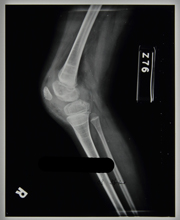|
Harris Lines
Harris Lines act a skeletal marker of stress inflicted on the body, usually during childhood. These occur when there is a lack of nutrients in the body as a result of malnutrition, and the bones stop growing. In childhood the long bones in the body grow continuously until the epiphyses, growth plates, at their ends fuse to the rest of the bone. When this growth is interrupted by malnutrition, or an infection that affects the body's ability to take in nutrients, and then resumes, following improvement in health and nutrition, a fresh layer of bone mineral is laid down as the beginnings of continued bone growth.
These lines are visible radiographically as opaque, white, transverse lines that appear at the ends of long bones close to the epiphyses. For individuals who have suffered several periods of stress there can be numerous lines, although those suffering from chronic illness may demonstrate with fewer lines than those whom have undergone several spates of malnutrition. Harris Lines can occur on any of the long bones but are most commonly seen in the legs on the femur and tibia.
It is noted regularly within the medical notes from Stannington Sanatorium that one of the symptoms of tuberculosis is a loss of appetite; patients were often described as being thin or anorexic on admission. Amongst the radiographs of these patients, Harris Lines feature frequently; however, it is impossible to say how many patients had these growth lines as not all patients have x-rays of their long bones. There is also the possibility that the social conditions these children came from had an impact on their nutritional health and hence their bone growth.
Patient 145/1946, a 3 years old girl, was admitted to Stannington in October 1945 with TB of the right knee. Her file is lacking in any general or family medical history but her initial medical notes on admission indicate a good overall general condition. After four years of treatment at Stannington for tuberculosis of the knee this girl was deemed fit for discharge in August 1949. However, the report to discharge this patient was met with a letter from a physician at the Tuberculosis Dispensary, Gateshead stating the home conditions for this girl were 'appalling', housing four adults and five children in just two rooms and therefore not to discharge this girl home but that he would endeavour to find alternative accommodation of her. This patient was finally discharged to Briarmede Nursery, Gateshead in November 1949. The poor social conditions of this patient are not uncommon amongst the files from Stannington and it is possible that they attribute to the formation of Harris Lines, alone or in conjunction with the tuberculosis infection. This demonstrates the secondary effects that disease and social conditions can have on an individual's body.
|
|


Click Images to Enlarge
|